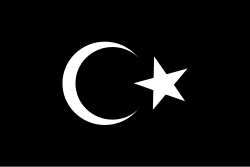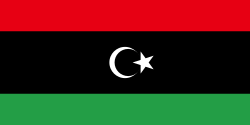Kungariket Libyen
| Kungariket Libyen | ||||
| المملكة الليبية al-Mamlakah al-Lībiyya (Arabiska) | ||||
| ||||
 | ||||
| Flagga | Vapen | |||
| Nationalsång: Libya, Libya, Libya | ||||
 | ||||
| Huvudstad | Tripoli, Benghazi och Al-Bayda¹ | |||
| Språk | Arabiska, Berberspråk | |||
| Religion | Islam | |||
| Statsskick | Konstitutionell monarki | |||
| Sista Kung | Idris I | |||
| Bildades | 24 december 1951 | |||
| – bildades genom | Avkolonisering | |||
| Upphörde | 1 september 1969 | |||
| – upphörde genom | Statskuppen i Libyen 1969 | |||
| Areal | 1759530 km² (1954) | |||
| Folkmängd | 1091830 (1954) | |||
| Valuta | Libyskt pund | |||
| Kungariket hade två huvudstäder | ||||
Kungariket Libyen, (arabiska: المملكة الليبية, översatt, Libyska kungariket) ursprungligen kallat Förenade Libyska kungariket skapades vid självständigheten den 24 december 1951 och fanns fram till en statskupp ledd av Muammar Gaddafi den 1 september 1969, som avsatte kung Idris av Libyen och skapade Libyska Arabrepubliken.
Libyens konstitution
Under konstitutionen från oktober 1951 styrdes den federala monarkin Libyen av kung Idris, och hans arvingar hade rätt att ärva tronen. Kungen hade stor politisk makt. Regeringen bestod av en premiärminister och ett ministerråd utsedda av kungen, vilka också var ansvariga inför Libyens deputeradekammare, underhuset. Libyens senat, överhuset, bestod av åtta representanter från vardera provins. Hälften av senatorerna nominaterades av kungen, som hade vetorätt i beslutsfattandet, samt rätt att upplösa underhuset. Provinsernas självstyre utövades av lokala regeringar och beslutande organ. Tripoli och Benghazi fungerade som huvudstäder.
Utrikespolitik
När det handlade om utrikespolitik brukade Kungariket Libyen räknas bland det konservativa traditionella blocket inom Arabförbundet, där man gick med 1953.[1]
Statskupp och monarkins avskaffande
Monarkin upphörde den 1 september 1969 då en grupp militära ledare under överste Muammar Gaddafi gjorde en statskupp mot kung Idris då han var i Turkiet för medicinsk behandling. Kuppmakarna arresterade arméchefen.
Indelning
Provinser
Från självständigheten och fram till 1963, bestod kungariket av tre provinser: Tripolitania, Cyrenaica och Fezzan, vilka var Libyens tre historiska regioner. Autonomin utövades av provinsregeringar och lokala beslutsfattande församlingar.
| Provins | Huvudstad | Area[2] |
|---|---|---|
| Tripolitanien | Tripoli | 276 000 km2 |
| Cyrenaica | Benghazi | 850 000 km2 |
| Fezzan | Sabha | 631 000 km2 |
1963 års omorganisation
Efter förändringar i konstitutionen 1963 avskaffades federalismen, och de tre provinserna delades in i 10 guvernement (muhafazah på arabiska) vilka styrdes av en utsedd guvernör.[3] [4]
- Bayda, tidigare del av Cyrenaica
- Al Khums, tidigare del av Tripolitania
- Awbari, tidigare del av Fezzan
- Az Zawiyah, tidigare del av Tripolitania
- Benghazi, tidigare del av Cyrenaica
- Darnah, tidigare del av Cyrenaica
- Gharian, tidigare del av Fezzan and Tripolitania
- Misrata, tidigare del av Tripolitania
- Sabha, tidigare del av Fezzan
- Tarabulus, tidigare del av Tripolitania
Källor
- Den här artikeln är helt eller delvis baserad på material från engelskspråkiga Wikipedia, 23 mars 2012.
Fotnoter
- ^ Federal Research Division of the Library of Congress, (1987), "Independent Libya", U.S. Library of Congress. läst 14 juli 2006.
- ^ Villard, Henry Serrano (1956), Libya: the new Arab kingdom of North Africa, Cornell University Press
- ^ Modern history in politics Arkiverad 6 augusti 2017 hämtat från the Wayback Machine. (in Arabic). Libya's future. Läst 15 oktober 2011.
- ^ "Municipalities of Libya"
Externa länkar
 Wikimedia Commons har media som rör Kungariket Libyen.
Wikimedia Commons har media som rör Kungariket Libyen.- Kingdom of Libya's constitution
- worldstatesmen.org
- Birth of a nation
- Independent Libya
Media som används på denna webbplats
Traditional banner of the Senussi and flag of Cyrenaica from 1949-1951.
Författare/Upphovsman: Пакко, Licens: CC BY-SA 3.0
Emblem of the Kingdom of Libya, known as the "Crown of Libya", after a design used during 1952-1969.
The constitution of the Kingdom of Libya of 1952 in article 7 describes the flag, but not the emblem. No official description is available at present (due to the restrictions placed on government archives since the military coup of 1969), and the design is reconstructed from many variants in shape and color schemes. The 24dec1951.com website conducted research into the design as represented in official government sources of 1952-1969, and describes the emblem as follows:
- Top Crown adorned with a white Crescent and five-pointed star at its summit, at which five visible side frames originating from a ring at the base converge. The star studded base and frame contain a velvet black head cover like object.
- The Top Crown is supported at its base by two beautiful plantar designs; in the form of three intertwined C and S scroll shapes.
- Two massive “Shoulder” frames contain the body of the crown from the right and left [...]. Each side is a complex formation of intertwined branches in the shape of an S Curve, which is essentially two back-to-back C scrolls; the larger one of which terminates in a large beautiful spiral at the top. [...]
- The background color of the large interior below the Top Crown can be white or transparent, although this is not evident in the picture of the Libyan pound. The background color of the center region surrounding the large white Crescent and Star is black as in the center stripe of the Libyan flag.
- A white ring with thin black borders, surrounds the center large white Crescent and Star.
- Nine five-pointed white stars surround the center ring.
- Large white crescent.
- Five pointed star located well above the perimeter of the crescent. This differs from the flag, which places the star at the extremities of the crescent.
- A Center Crown, seated above the ring containing the Crescent and Star. Its design is identical to the Top Crown, except for being smaller in size.
- Plantar/ floral ornamentation similar to #2 above, providing variation and connectivity to the base.
- At the base, an elegant design that resembles a document scroll with a ring tie at its center. It is noted that the color scheme of the crown is most likely white for the stars and crescents, black and white (or transparent) for spaces, and gold for the crowns and frames. [...]
The Ottoman Turks conquered the country in the mid-16th century, and the three States or "Wilayat" of Tripolitania, Cyrenaica and Fezzan (which make up Libya) remained part of their empire with the exception of the virtual autonomy of the Karamanlis. The Karamanlis ruled from 1711 until 1835 mainly in Tripolitania, but had influence in Cyrenaica and Fezzan as well by the mid 18th century.
Flag of the Libyan Arab Republic (1969-1972)
Orthographic map of Libya







